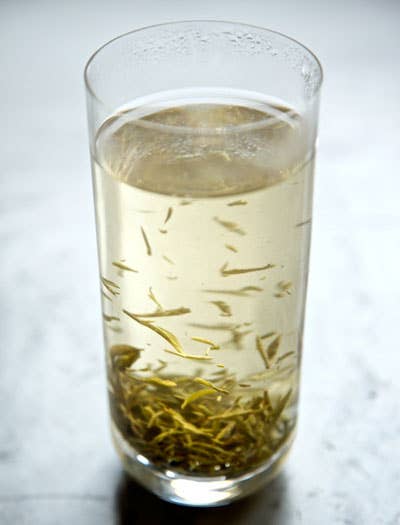
Spring Snail Tea
Last spring when I was traveling in China, I sat down in a cafe in the city of Suzhou (a couple of hours northwest of Shanghai) and asked the waitress if the region had any specialty teas. She immediately brought me a tall, thin glass of hot water with long tea leaves floating in it. At first glance, it looked like a regular green tea, and I thought it might be longjing, or "dragon well" tea, which is famous throughout China and grown in the region south of where I was, but as the leaves unfurled, I could see that they were covered with a silvery down that came off into the water, turning it slightly cloudy. "This is biluochun tea," the waitress told me. "It's from the mountains around here." By the time the water was cool enough to drink, the tea had turned a light honey color and had an earthy, nutty fragrance. The brew's flavor was subtler than I'd expected, had a slight sweetness to it, and combined green tea's usual grassy, tannic notes with hints of peaches, oranges, and even almonds.
Intrigued, I headed to a teashop that afternoon to see if anyone there could tell me more about this variety of tea, and I was surprised to find that the entire front of the shop was taken up by large, stainless-steel containers of biluochun in grades that ranged in price from $1.50 to $50 an ounce. This tea, it turned out, is one of the most famous in all of China. Its name—literally "jade insect spring" but better translated as "green spring snail"—comes from the fact that the tea is harvested only in spring, usually around the time of the vernal equinox, and from the curly shape the leaves take when they are dried. Like most Chinese teas, it can be steeped multiple times, and as the brew gets weaker and lighter, different layers of its flavor come to the fore.
I left the shop that day loaded with lots of small bags of biluochun in various grades, but once I'd returned home to the U.S., I quickly ran out. Luckily, a number of specialty teahouses and importers carry it, including the Tea Gallery and Ten Ren Tea (where it's referred to as pi lo chun), so I can enjoy a little cup of spring no matter what the time of year.
Keep Reading
Continue to Next Story










